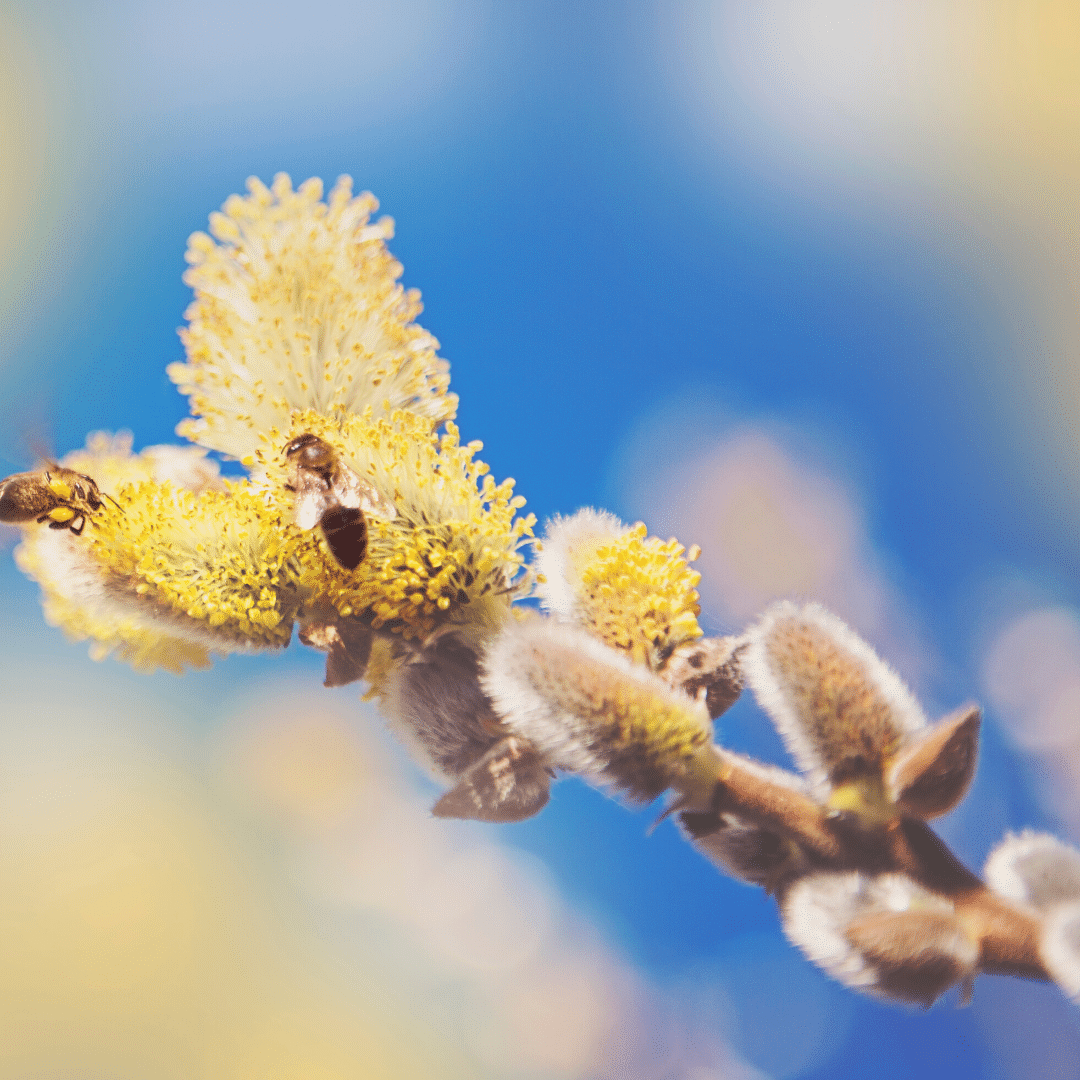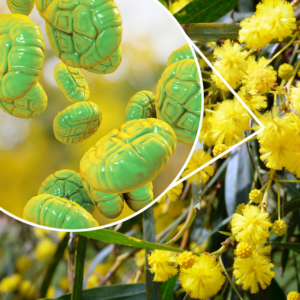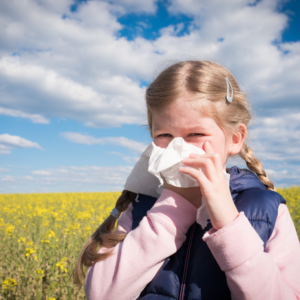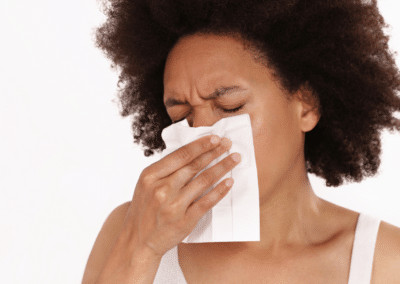Are pollen allergies genetic? Read on to find out how we define pollen and discuss how a nose filter can be an effective alternative to pollen-allergy medicine.
Pollen is a vital lifeline for the botanical world, and by extension the human world. But it can also be a powerful nuisance to many of us with seasonal allergies. Pollen allergies affect approximately 20% of the US population. So let’s have a look at how we define pollen, why it affects some, and how nasal filters can help you get through allergy season.
Pollen: What is it exactly?
Sometimes referred to as the sperm of the plant world, pollen is the substance produced by trees, grass, flowers, and weeds to fertilize those of the same species.
For the pollination process to take place, pollen is transferred by insects or, in some cases, the wind, from the male part of one plant to the female part of another. Once pollination has occurred, the fertilized plant is then able to produce seeds to reproduce its own kind. Without pollen, and pollinators, we would not have trees, plants, food, etc. So it’s pretty important.
Pollen generally appears as a dusty or powdery substance and can vary from fine to coarse in texture. The lightness of pollen and its ability to effortlessly travel vast distances through the air is great for the propagation of plants but, unfortunately, can provoke frustrating and uncomfortable allergy symptoms for many people.
Pollen comes in a variety of shapes and sizes, depending on the plant it originates from, and generally ranges from 10-100 µm in diameter.
| Plant Pollen | Particle Size (micrometers – µm) |
| Bermuda Grass | 38-40 |
| Birch | 18-30 |
| Blue Grass | 22-122 |
| Cedar | 2.5-200 |
| English Plantain | 26-31 |
| Grass | 20-25 |
| Lamb’s Quarters | 14-50 |
| Nettle | 12-15 |
| Oak | 24-38 |
| Pine | 60-100 |
| Poplar | 25-40 |
| Ragweed | 19-20 |
| Tumbleweed | 18-31 |
| Walnut | 30-40 |
Why is it Tricky for Some and Not Others?
So why does pollen create havoc for some but allow others to escape sniffle-free? Are pollen allergies genetic and how did you end up with it?
Once considered seasonal, pollen allergies have now become an all-year-round issue for many and it can take as little as a few grains of pollen to trigger a massive allergic reaction in some. Plant pollen levels vary between species and the main allergy-triggering pollens are found in weeds, trees, and grasses.
Susan Waserman, a professor of medicine in the division of clinical immunology and allergy at McMaster University in Canada, suggests that in a lot of cases humans become allergic or sensitized to things they were regularly exposed to as children, such as certain food, pet hair, and pollen. Professor Waserman also believes genetics can play a role and suggests some people are more genetically inclined to form allergies than others.
An allergy will form when the immune system mistakes a harmless protein for a harmful one, and once this occurs, unfortunately, the allergy is here to stay. Once the allergy is adopted, each time the body comes into contact with what it assumes to be the enemy, the immune system takes action by producing histamine. Professor Waserman also believes that the immune system makes these misjudgments when it’s busy fighting off viruses such as a cold but this has yet to be confirmed.
Have you ever wondered why there are more children with allergies now than in the past? Professor Waserman stated “People whose immune systems are no longer busy fighting infection become disregulated and allergic.” Also, with the use of antibacterial products on the rise and an increase in better food-hygiene practices, children are exposed to far fewer microbes and this contributes to the immune system’s inability to recognize friendlier microorganisms, such as pollen, and confusing them with harmful ones.
The Impact of Pollen Allergy and Intolerance
A runny, blocked nose; itchy, swollen eyes; sneezing; scratchy throat; and an intense fear of leaving the house, these are all classic allergy symptoms. But these effects are often underestimated and can have severe consequences beyond those mentioned here.
A simple change in season, freshly cut grass, or a windy day can result in major work and life disruptions for those with a pollen allergy. Lack of energy, poor sleep, and severe exhaustion are the realities for many pollen-allergy sufferers and can lead to emotional and physical stress.
Not all reactions are the result of inhaling the pollen allergen. Digging around in the garden can also be risky business for some. A pollen-allergy rash can form when skin comes in direct contact with the allergen and can quickly turn into uncomfortable hives.
For long-term sufferers, the risk of allergic asthma is a major concern. An allergy and asthma can form a mighty team when the allergy moves from the upper respiratory system to the lower and creates hypersensitivities in the bronchial tract. Pollen becomes an even bigger enemy by causing allergy-induced asthma attacks. In severe cases, pollen allergies can lead to chronic bronchitis, affect lung health and the respiratory system, or even create a lung infections.
How Nasal Filters Can Help
So let’s talk about how to kick your allergy to the back seat and take control of your life.
Sure, you could reach for that pollen-allergy medicine, but according to Christian Nordqvist at Medical News today, the most effective way to treat an allergy is to avoid the allergen altogether. But with it being so pervasive, how can you steer clear of pollen?
The particle size of pollen generally ranges from PM10-PM100. Our Nasal Dilators with 3M Filter Media block 90% of particles over PM10, and nearly 100% as the particle size increases.
Source: Wikimedia Commons By Jisaac9
Comfortable and discreet, nasal filters are designed to sit just inside of the nasal cavity and act as a protective barrier between your nose and airborne allergens. As you inhale, the nasal filter intervenes to filter the air before it reaches your nasal passages and has the chance to stir up allergy symptoms.
If you’ve been dealt the allergy card, burying your head in the sand–or in this case, pollen–won’t make it disappear! Taking action for your health woes is the best way to move forward, and learning how to manage and understand your allergy is key. A nasal filter is a simple, effective option to minimize your allergy symptoms or allergy asthma and maximize your quality of life.






